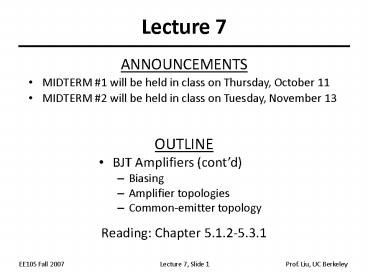ANNOUNCEMENTS PowerPoint PPT Presentation
1 / 25
Title: ANNOUNCEMENTS
1
Lecture 7
- ANNOUNCEMENTS
- MIDTERM 1 will be held in class on Thursday,
October 11 - MIDTERM 2 will be held in class on Tuesday,
November 13
- OUTLINE
- BJT Amplifiers (contd)
- Biasing
- Amplifier topologies
- Common-emitter topology
- Reading Chapter 5.1.2-5.3.1
2
Biasing of BJT
- Transistors must be biased because
- They must operate in the active region, and
- Their small-signal model parameters are set by
the bias conditions.
3
DC Analysis vs. Small-Signal Analysis
- Firstly, DC analysis is performed to determine
the operating point and to obtain the
small-signal model parameters. - Secondly, independent sources are set to zero and
the small-signal model is used.
4
Simplified Notation
- Hereafter, the voltage source that supplies power
to the circuit is replaced by a horizontal bar
labeled VCC, and input signal is simplified as
one node labeled vin.
5
Example of Bad Biasing
- The microphone is connected to the amplifier in
an attempt to amplify the small output signal of
the microphone. - Unfortunately, there is no DC bias current
running through the transistor to set the
transconductance.
6
Another Example of Bad Biasing
- The base of the amplifier is connected to VCC,
trying to establish a DC bias. - Unfortunately, the output signal produced by the
microphone is shorted to the power supply.
7
Biasing with Base Resistor
- Assuming a constant value for VBE, one can solve
for both IB and IC and determine the terminal
voltages of the transistor. - However, the bias point is sensitive to ?
variations.
8
Improved Biasing Resistive Divider
- Using a resistive divider to set VBE, it is
possible to produce an IC that is relatively
insensitive to variations in ?, if the base
current is small.
9
Accounting for Base Current
- With a proper ratio of R1 to R2, IC can be
relatively insensitive to ?. However, its
exponential dependence on R1 // R2 makes it less
useful.
10
Emitter Degeneration Biasing
- RE helps to absorb the change in VX so that VBE
stays relatively constant. - This bias technique is less sensitive to ? (if I1
gtgt IB) and VBE variations.
11
Bias Circuit Design Procedure
- Choose a value of IC to provide the desired
small-signal model parameters gm, r?, etc. - Considering the variations in R1, R2, and VBE,
choose a value for VRE. - With VRE chosen, and VBE calculated, Vx can be
determined. - Select R1 and R2 to provide Vx.
12
Self-Biasing Technique
- This bias technique utilizes the collector
voltage to provide the necessary Vx and IB. - One important characteristic of this approach is
that the collector has a higher potential than
the base, thus guaranteeing active-mode operation
of the BJT.
13
Self-Biasing Design Guidelines
(1) provides insensitivity to ? . (2) provides
insensitivity to variation in VBE .
14
Summary of Biasing Techniques
15
PNP BJT Biasing Techniques
- The same principles that apply to NPN BJT biasing
also apply to PNP BJT biasing, with only voltage
and current polarity modifications.
16
Possible BJT Amplifier Topologies
- There are 3 possible ways to apply an input to an
amplifier and 3 possible ways to sense its
output. - In practice, only 3 out of the possible 6
input/output combinations are useful.
17
Common-Emitter (CE) Topology
18
Small Signal of CE Amplifier
19
Limitation on CE Voltage Gain
- Since gm IC/VT, the CE voltage gain can be
written as a function of VRC , where VRC VCC -
VCE. - VCE should be larger than VBE for the BJT to be
operating in active mode.
20
Voltage-Gain / Headroom Tradeoff
21
I/O Impedances of CE Stage
- When measuring output impedance, the input port
has to be grounded so that vin 0.
22
CE Stage Design Trade-offs
23
Inclusion of the Early Effect
- The Early effect results in reduced voltage gain
of the CE amplifier.
24
Intrinsic Gain
- As RC goes to infinity, the voltage gain
approaches its maximum possible value, gm rO,
which is referred to as the intrinsic gain. - The intrinsic gain is independent of the bias
current
25
Current Gain, AI
- The current gain is defined as the ratio of
current delivered to the load to current flowing
into the input. - For a CE stage, it is equal to ?.

